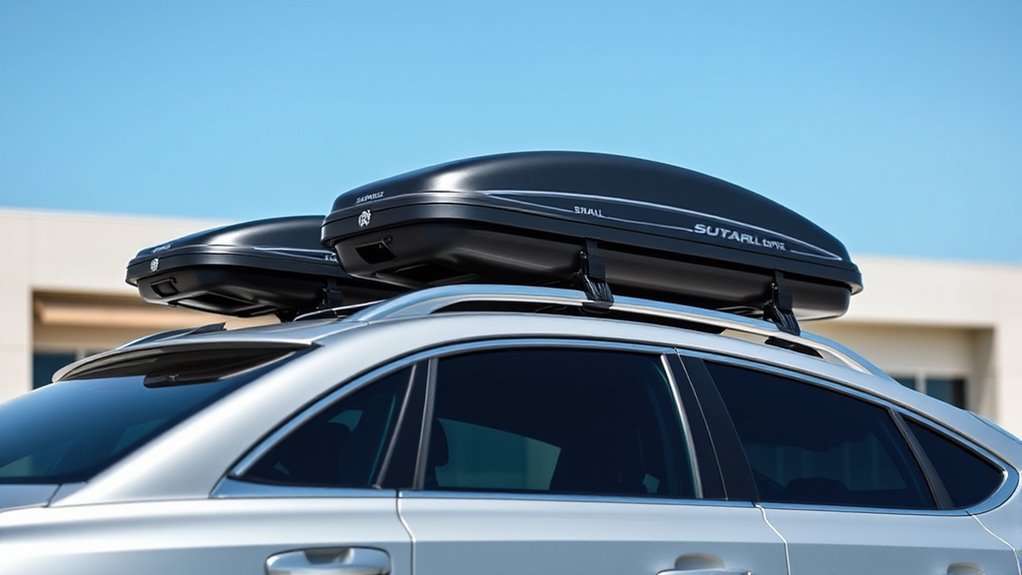To choose the right roof box size, first check your vehicle’s roof load capacity and measure its dimensions. Consider how much gear or equipment you’ll carry, including bulky or fragile items, and select a box that matches your space needs without overloading your car. Think about ease of access, aerodynamics, and security features for safe travel. Keep in mind your budget and vehicle compatibility—more details can help you make the best choice for your trip.
Key Takeaways
- Measure your vehicle’s roof dimensions and ensure the roof box size fits securely without overhanging edges.
- Consider your storage needs based on trip length, gear volume, and the number of travelers.
- Match the roof box capacity to your gear size, weight, and fragility for safe, efficient packing.
- Opt for a size that maintains vehicle aerodynamics and fuel efficiency, avoiding overly bulky options.
- Check your roof load capacity and subtract the box weight to select a size that stays within safety limits.
Assessing Your Vehicle’s Roof Load Capacity

Before choosing a roof box size, it’s essential to know your vehicle’s roof load capacity. Your vehicle’s roof can only support a specific weight, including the box, gear, and contents. Check your owner’s manual or look for a sticker inside the driver’s door frame to find this information. Overloading your roof can compromise safety and damage your vehicle’s structure. Keep in mind that the load capacity includes the weight of the roof box itself, so subtract that to determine how much gear you can pack. Always err on the side of caution, and avoid exceeding the recommended limit. Knowing your roof’s capacity helps you select a safe, suitable roof box size and ensures you enjoy your trip without risking damage or accidents.
Determining Your Storage Needs
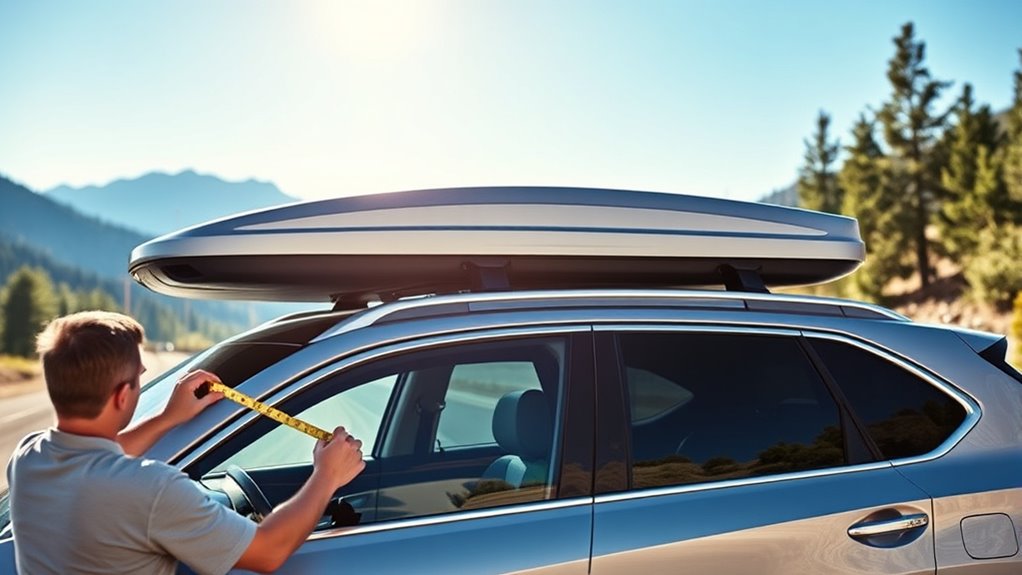
To choose the right roof box size, you need to accurately determine your storage needs. Think about what you’ll be packing for your trip—clothes, gear, or bulky equipment. Consider the following:
- The number of travelers and their packing requirements
- The types of items, especially if they are large or irregularly shaped
- Duration of your trip, which influences how much you’ll need
- The overall wall organization system in your vehicle or home to optimize space utilization. Implementing effective storage solutions can help you better assess available space and prevent clutter buildup, ensuring your chosen roof box size fits seamlessly into your packing plan. Additionally, understanding the storage organization or contrast ratio of your storage setup can help you evaluate how well your items are organized and visible within the space.
Considering the Types of Items to Carry
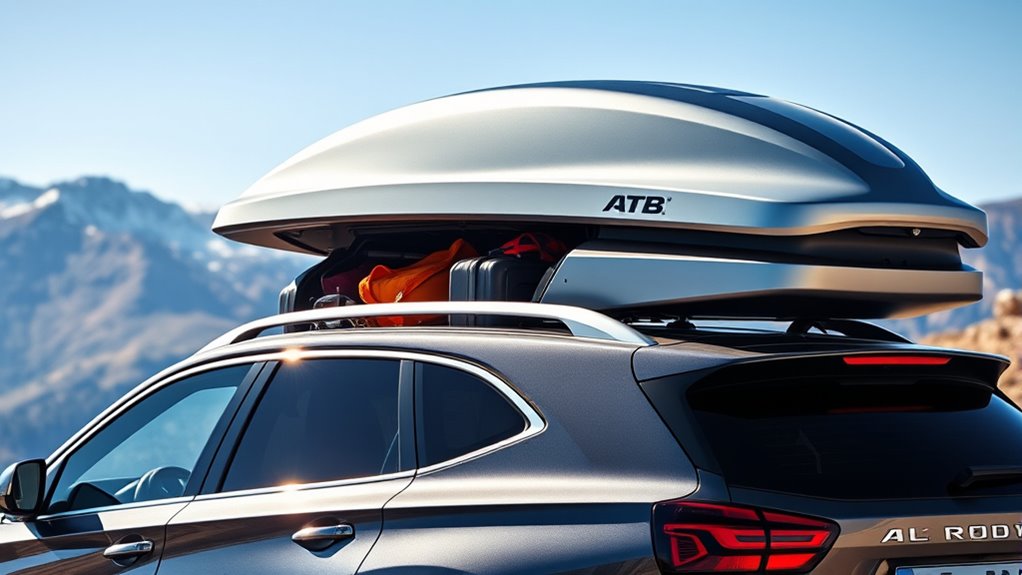
Understanding the types of items you’ll carry is essential for selecting the right roof box size. If you plan to transport bulky gear like camping equipment or sports gear, you’ll need a larger, more spacious box. Soft items such as clothing or lightweight blankets can be packed efficiently in smaller or medium-sized boxes. Fragile items, like glassware or electronics, require extra padding and secure placement, which may influence your choice of box size and internal features. Heavy items, like tools or ski boots, need to be positioned carefully to avoid overloading the roof. Consider how you’ll organize your gear to ensure everything fits comfortably without compromising safety or accessibility. Matching your items’ size, weight, and fragility to the roof box helps prevent damage and makes packing easier. Additionally, understanding spearfishing safety and local regulations can inform how you pack delicate or valuable gear to ensure both safety and compliance. Proper weight distribution and adherence to payment processing guidelines can also help maintain vehicle stability during travel. Incorporating personality traits of organized packing can optimize space utilization and prevent last-minute frustrations.
Matching Roof Box Sizes to Vehicle Dimensions
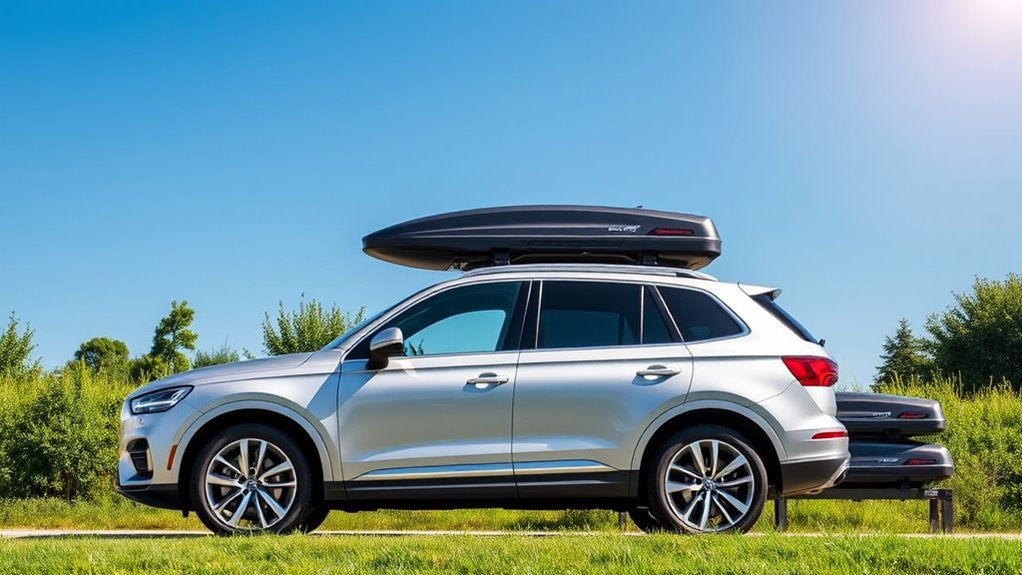
To find the right roof box, you need to consider your vehicle’s roof dimensions to ensure a proper fit. Choosing a size that matches your car’s storage capacity prevents overloading and maintains safety. By aligning your roof box with your vehicle’s specifications, you maximize space without compromising performance. Additionally, creating a comfortable bedroom ambiance can be achieved by selecting appropriate features that complement your overall vehicle setup, especially when considering remote work options to make long trips more comfortable. Being aware of culinary uses of chia seeds can inspire you to incorporate healthy snacks during your travels, enhancing your journey with nutritious options.
Vehicle Roof Dimensions
How do you guarantee your roof box fits perfectly on your vehicle? Start by measuring your roof’s dimensions, including length, width, and height. Check your vehicle’s weight limits and ensure the roof can support the roof box and its contents. Keep in mind that different vehicles have varying roof shapes and rail types, affecting compatibility. Additionally, consider the impact of automated systems on the vehicle’s roof weight capacity and overall fit. Understanding angel number symbolism can also help you interpret signs that your chosen roof box is the right fit, ensuring a harmonious match between your vehicle and accessories. Incorporating proper installation techniques ensures safety and optimal performance of your roof box during travel. Being aware of juice detox side effects can help you prepare appropriately if you decide to combine travel with health routines.
Optimal Storage Capacity
Choosing the right roof box size involves matching its storage capacity to your vehicle’s dimensions to maximize space without compromising safety or stability. To do this, measure your roof’s available space and consider your typical luggage needs. If you pack light, a smaller box suffices; for family trips, opt for a larger capacity. Ensure the roof box doesn’t extend beyond your vehicle’s width or height, which could affect aerodynamics and safety. Remember, a box that’s too small won’t hold everything, forcing you to leave items behind. Conversely, an oversized box may add unnecessary weight and affect handling. Find a balance that provides enough storage while maintaining your vehicle’s stability. Properly matching capacity guarantees a safe, efficient, and organized trip. Additionally, consider the water content of vegetable juices, as higher water content can influence the weight and aerodynamics of your roof box. Ensuring your roof box’s compatibility with your vehicle’s headphone jacks can also help in entertainment during long trips. Being aware of vehicle weight limits is crucial to prevent overloading and ensure safe driving conditions.
Evaluating Installation and Accessibility
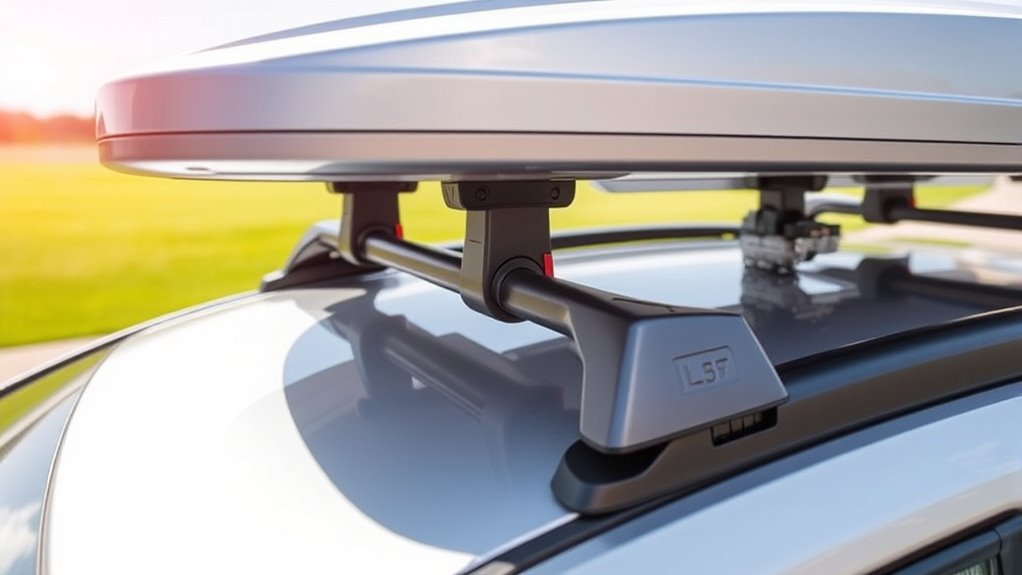
When selecting a roof box, consider how easy it is to install and secure on your vehicle. You’ll also want to think about how accessible it is for loading and unloading, making sure it’s comfortable to reach. Prioritizing these factors helps ensure you choose a box that’s both practical and safe for your needs.
Mounting Ease and Security
Mounting a roof box can vary in ease depending on its design and your vehicle. Some models feature quick-release clamps, making installation straightforward, while others require more tools and effort. Security is equally important—you want to verify your gear stays safe during transit. Look for features like reinforced locks and anti-theft systems that give you peace of mind. Additionally, selecting a model with simple mounting can reduce setup time and frustration. Choosing a roof box with reliable security ensures your cargo remains protected during your trip. To evaluate mounting ease and security, consider:
- Ease of installation: Does it come with clear instructions and minimal tools?
- Attachment system: Are the mounting points compatible with your roof rails?
- Locking mechanisms: Are they sturdy and tamper-proof? Considering the availability of local installation resources can also help simplify setup and ensure proper security. Additionally, examining the construction quality of the roof box can further influence its security and durability during travel.
Access Convenience and Ergonomics
Ease of installation and accessibility play a significant role in how satisfied you’ll be with your roof box. When choosing, consider how easy it is to load and unload your gear without hassle. An ergonomic design reduces strain and saves time, especially if you’ll frequently access the box. Think about the height of your vehicle and whether you’ll need a step or lift. Also, check if the opening mechanism is user-friendly and accessible from your parking spot. Use this quick comparison to evaluate:
| Feature | Benefits |
|---|---|
| Low-profile design | Easier to reach and install |
| Side-opening access | Convenient from either side |
| Gas-strut assisted | Simplifies opening and closing |
| Height of the box | Impacts ease of access |
| Locking mechanisms | Ensures secure, quick access |
Additionally, considering ergonomic design features can greatly enhance your overall experience by minimizing fatigue during frequent access. Incorporating features like user-friendly mechanisms and adjustable components can further optimize comfort and efficiency.
Ensuring Safety and Aerodynamics
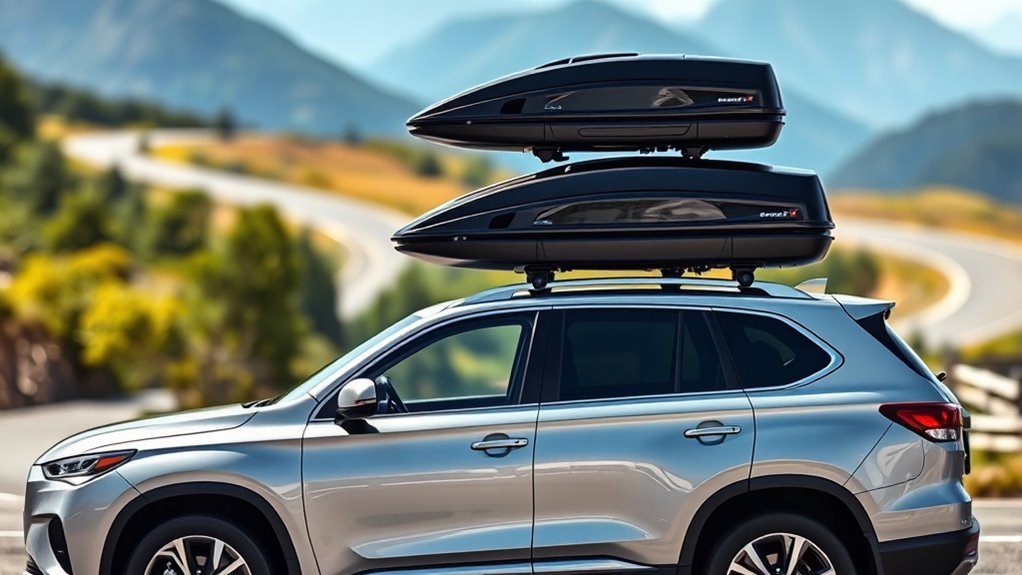
To guarantee safety and ideal aerodynamics, selecting a roof box that fits securely and maintains a streamlined profile is essential. An ill-fitting or bulky box can create drag, increase fuel consumption, and compromise stability. Ensure your roof box is properly mounted, with all locking mechanisms secure, to prevent accidents on the road. Keep in mind these key points:
A secure, aerodynamic roof box enhances safety, reduces drag, and maintains vehicle stability during travel.
- Choose a size that aligns with your vehicle’s roof dimensions for a snug fit
- Opt for a sleek, aerodynamic design to reduce wind resistance
- Regularly inspect mounting hardware and locks for wear or damage
- Selecting a roof box made from lightweight, durable materials can further improve vehicle efficiency and overall performance. Additionally, considering regulatory compliance and choosing reputable manufacturers can help ensure safety standards are met. Proper installation and maintenance are crucial for safe transport and maximizing the lifespan of your roof box.
Budgeting for Your Roof Box Investment
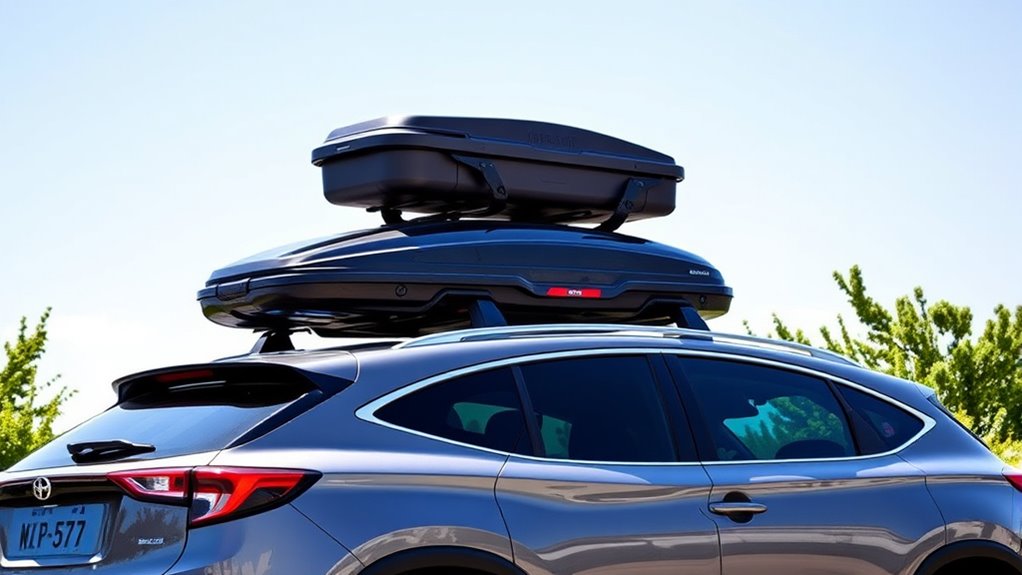
Budgeting for your roof box is an important step to guarantee you get a quality product without overspending. Start by setting a clear budget based on how often you’ll use it and its essential features. Consider the initial cost, installation fees, and potential maintenance. To help you decide, review this quick comparison:
| Budget Range | Key Features | Ideal For |
|---|---|---|
| $200 – $400 | Basic models, lightweight, simple locking | Occasional travelers |
| $400 – $700 | Enhanced durability, better aerodynamics | Frequent use, long trips |
| $700+ | Premium materials, advanced security | Regular travelers, large families |
Staying within your budget ensures you choose a roof box that meets your needs without unnecessary expense. Additionally, understanding the various roof box sizes can help you select the best fit for your vehicle and travel needs, especially considering the different roof box capacities available on the market. Conducting thorough research can also help you identify compatible vehicle types to ensure a proper fit, which is essential for safety and performance. When selecting a size, consider the hybrid bicycle of your vehicle to ensure compatibility and optimal storage.
Frequently Asked Questions
Can a Larger Roof Box Impact My Vehicle’s Fuel Efficiency?
A larger roof box can definitely impact your vehicle’s fuel efficiency. When you add more weight and increase wind resistance, your engine works harder to maintain speed, which uses more fuel. If you’re planning long trips or want to save on gas, consider a smaller, more aerodynamic roof box. This way, you minimize drag and weight, helping you keep fuel costs down while still carrying what you need.
How Do I Secure Items Inside a Roof Box for Safety?
Many believe securing items inside your roof box isn’t vital, but truthfully, it’s essential for safety. You should use bungee cords, straps, or netting to tightly fasten your belongings. Make sure heavier items are placed at the bottom and evenly distributed. Double-check the straps before hitting the road. Properly secured items prevent shifting, reduce noise, and protect you and your passengers from potential hazards during transit.
Are There Legal Restrictions on Roof Box Sizes in Different Regions?
You should verify regional laws before using a roof box. Some areas have restrictions on how much extra height or weight you can add to your vehicle, which might limit your roof box size. Always review local traffic regulations or consult your vehicle’s manual to avoid fines or safety issues. Staying within legal limits ensures you can enjoy your trip without worries about violating regulations or risking safety.
How Does Weather Affect the Choice of Roof Box Size?
Weather can turn your trip into a rollercoaster ride, so it’s vital to factor in how it affects your roof box size. If rain or snow is forecasted, opt for a smaller, more secure box to prevent instability and water ingress. Strong winds demand a compact design to minimize drag and noise. Always check weather conditions beforehand, ensuring your roof box stays safe and stable, no matter what Mother Nature throws your way.
Can I Install a Roof Box on a Vehicle With a Sunroof?
You can install a roof box on a vehicle with a sunroof, but you need to be cautious. First, check if your sunroof opens fully or partially, and make certain the roof box won’t interfere with it. You might need to choose a smaller box or adjust the mounting position. Always follow your vehicle manufacturer’s guidelines and consider consulting a professional to avoid damaging your sunroof or affecting vehicle safety.
Conclusion
Choosing the right roof box size guarantees you maximize storage without compromising safety or performance. For example, if you’re planning a family road trip, a medium-sized box might hold all your luggage comfortably. Remember to take into account your vehicle’s roof load capacity and your specific needs. By matching the right size to your vehicle and trip, you’ll enjoy a smooth, hassle-free journey, making every adventure more enjoyable and stress-free.
